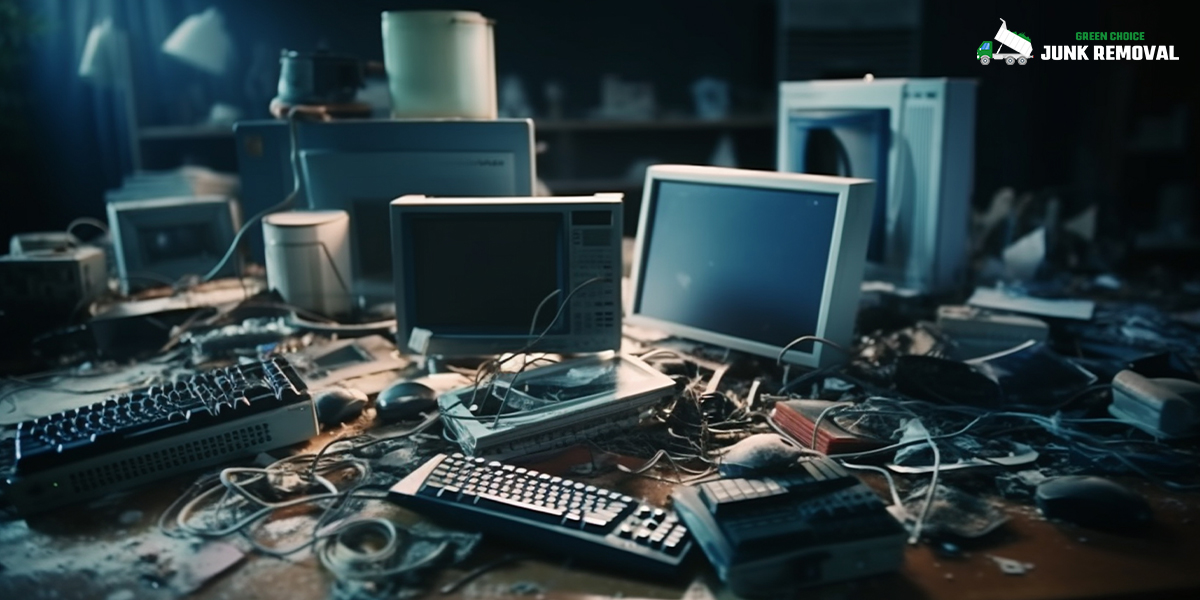E-waste, often known as electronic garbage, has grown to be a major issue in the modern world. The volume of electronic waste produced globally is astounding due to the sudden influx of electronic devices and the rising demand for new technologies.
In 2023, the United Nations projects that there will be 8 kg of electronic waste produced globally per person. This translates to 61.3 million metric tons of electronic garbage being dumped within a year, with just 20% being adequately recycled.
The remainder is disposed of in landfills, where it contaminates the soil, water, and air and endangers both people and wildlife’s health. This blog covers the detailed impact of electronic waste on both the environment and our health. As well as effective ways to manage electronic waste.
What Comes Under The Category of Electronics Recycling?
Electronics recycling services includes a wide range of items such as computers, laptops, mobile phones, tablets, televisions, printers, scanners. Most of these devices contain valuable materials like copper, gold, silver, and platinum, which can be recovered through recycling.
Other components like batteries, circuit boards, and cables can also be recycled. However, not all electronic waste can be recycled in the same way. Some items may require specialized processing facilities, while others can be disposed of through local recycling programs.
Harmful Environmental Impacts of Electronic Waste
Electronic waste poses significant environmental threats due to its hazardous components. Which can contaminate soil, air, and water when disposed of improperly. Some of the most common environmental impacts of e-waste include:
Leachate: E-waste can produce a toxic liquid called leachate, which forms when rainwater or snow seeps into piles of discarded electronics. Leachate can seep into the ground and contaminate soil and groundwater. Posing serious risks to both human health and the environment.
Air Pollution: When e-waste is burned in open fires, it releases toxic gases, including particulate matter (PM), nitrogen oxides (NOx), sulfur dioxide (SO2), and volatile organic compounds (VOCs). These pollutants can cause respiratory problems, lung disease, and other health issues.
Water Pollution: Electronic waste can also contaminate water sources through various pathways, including direct dumping, runoff from landfills, and leachate spills. Toxic chemicals from e-waste can enter water bodies, affecting aquatic life and human health.
Soil Contamination: Improper disposal of e-waste can result in soil contamination, either through direct dumping or leachate seepage. This can have long-term consequences for agricultural productivity, biodiversity, and ecosystem health.
Climate Change: The production and disposal of electronic devices contribute to climate change due to the energy required for manufacturing, transportation, and recycling. Additionally, the use of certain materials in electronics, such as rare earth elements, can contribute to greenhouse gas emissions.
Health Impacts of Improper Electronics Recycling
The improper disposal of electronic waste can have severe health implications for humans, especially in areas where e-waste is processed or disposed of unsafely. Some of the most common health impacts of e-waste include:
Cancer: Exposure to certain chemicals found in e-waste, such as dioxins and furans, has been linked to an increased risk of cancer. Burning e-waste can release these toxins into the air, putting nearby communities at risk.
Respiratory Problems: Inhaling particles and fumes from burning e-waste can cause respiratory problems, such as bronchitis, asthma, and other chronic lung diseases. Workers in informal electronics recycling facilities are particularly susceptible to these health risks.
Neurological Effects: Exposure to heavy metals, such as lead, mercury, and arsenic, can damage the nervous system and cause neurological problems, including cognitive impairment, memory loss, and tremors.
Reproductive Issues: Certain chemicals found in e-waste, such as PCBs and PVCs, have been linked to reproductive problems, including birth defects and reduced fertility.
Skin Disorders: Contact with toxic chemicals in e-waste can cause skin irritation, rashes, and other dermatological problems. Prolonged exposure can lead to more severe skin disorders, such as skin cancer.
Eye Irritation: Inhaling dust and fumes from e-waste can cause eye irritation, tearing, and sensitivity to light. Prolonged exposure can lead to cataracts, glaucoma, and age-related macular degeneration.
Cardiovascular Disease: Exposure to certain chemicals in e-waste, such as lead and cadmium, has been linked to an increased risk of cardiovascular disease, high blood pressure, and stroke.
How to Effectively Manage Electronic Waste
Managing electrical recycling with proper care is crucial. Here are six ways to manage electronic waste:
Hire a junk removal service provider:
Consider hiring a professional junk removal service provider that specializes in electronics recycling service. They will have the necessary equipment and expertise to safely and efficiently remove and dispose of your electronic waste.
Recycle:
Recycling electronic waste responsibly is critical to minimizing its environmental impact. Ensure that your organization has a robust recycling program in place, which includes collecting electronic waste separately from regular trash, labeling it correctly, and sending it to certified recyclers.
Donate:
Donate working electronics to charities, schools, or non-profit organizations. Many organizations accept computer donations and refurbish them for low-income families, schools, and non-profits.
Refurbish:
Refurbish electronic devices instead of replacing them. This can save money and reduce waste.
Buyback:
Implement a buy-back program for electronic devices. This allows customers to sell their old devices to the company, which can then refurbish and resell them.
Properly Dispose of Batteries:
Batteries contain hazardous substances such as lead, mercury, and cadmium. Which can contaminate soil and water if not disposed of properly. Make sure to dispose of batteries in designated receptacles or through a battery recycling program.
Conclusion:
It’s essential to address the environmental and health impacts of electronic waste through sustainable practices. Such as recycling, refurbishing, and properly disposing of electronic devices. Governments, organizations, and individuals, especially in developing countries, must work together to mitigate the adverse effects of toxic e-waste and promote a safer, more environmentally conscious digital landscape.




